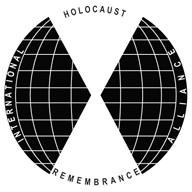“Our commitment must be to remember the victims who perished, respect the survivors still with us, and reaffirm humanity's common aspiration for mutual understanding and justice.”
-- Declaration of the Stockholm International Forum on the Holocaust
 INTERNATIONAL HOLOCAUST REMEMBRANCE ALLIANCE
INTERNATIONAL HOLOCAUST REMEMBRANCE ALLIANCE
“Our commitment must be to remember the victims who perished, respect the survivors still with us, and reaffirm humanity's common aspiration for mutual understanding and justice.”
-- Declaration of the Stockholm International Forum on the Holocaust
An exhibition entitled "The Holocaust by Bullets: Mass-Scale Shootings of Jews in Ukraine in 1941-44" opened in Kiev, Ukraine on 8 September, and will be displayed until 3 October.
This is the first time the exhibit has been displayed in Ukraine, and is presented by a partnership of Memorial de la Shoah, Yahad - In Unum, The Victor Pinchuk Foundation, and the Ukrainian Embassies of Israel, France, Germany and the United States. It seeks to promote tolerance and prevent discrimination by increasing public awareness and understanding, particularly among younger generations, of the history of the mass murder of Jews and other victims by Nazi soldiers in Ukraine.
"The Holocaust by Bullets" focuses on the Jewish victims in Soviet Ukraine during the Holocaust by using text, photos, artifacts, and witness testimonies. It is based on the work of Father Patrick Desbois, the head of Yahad-In Unum, and was created by the Memorial de la Shoah with the help of leading Ukrainian experts. It includes information on historical facts, video interviews, wartime documents, photographs of mass graves that have been discovered, and objects documenting the history of the mass shootings. An educational program created by the USC Shoah Foundation Institute for Visual History and Education and the Ukrainian Centre for Holocaust Studies will be carried out concurrently in order to involve, inform and engage Ukrainian students in a dialogue on the subject.
The exhibit is part of the program commemorating the 70th anniversary of the Babi Yar massacres, which Ukraine will mark later this month. Babi Yar is a ravine outside of Kiev where an estimated 34,000 Jews were killed on September 29-30, 1941.
The opening of the exhibition was attended by Baron Eric de Rothschild, President of the Memorial de la Shoah, former Ukrainian President Leonid Kuchma, philanthropist and businessman Viktor Pinchuk, the ambassadors of Israel, France, Germany, the United States, and the United Kingdom, as well as prominent historians and experts in the field.
The exhibit was previously displayed in Paris, Brussels, and New York City.